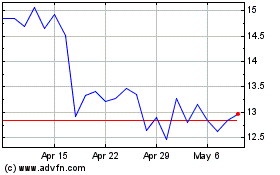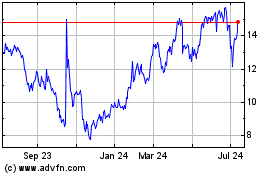Assembly Biosciences, Inc. (Nasdaq: ASMB), a clinical-stage
biotechnology company developing innovative therapeutics targeting
hepatitis B virus (HBV) and diseases associated with the
microbiome, announced that data for its first and second generation
HBV core inhibitors were highlighted during today’s late-breaker
poster session at the American Association for the Study of Liver
Diseases (AASLD) Annual Meeting (The Liver Meeting®) in Boston,
Massachusetts. The posters featured final 24-week results and
interim long-term data from the Phase 2 studies of ABI-H0731 (731).
Additionally, the company presented initial data from the first
dose cohort in the ongoing Phase 1b study of ABI-H2158 (2158). The
posters will be made available on the Investors page of the
assemblybio.com website.
“It’s encouraging to see innovation and evolution coming to this
field, given the impact of HBV infection globally and limited
ability of current therapies to fully suppress the virus,” said Dr.
Kosh Agarwal, Kings College Hospital, London. “Assembly presented
the first data to suggest that a core inhibitor can potentially
reduce cccDNA levels, as reflected by observed reductions in pgRNA
and HBV viral antigens. As physicians treating these patients, we
would all like to see new regimens that could bring about viral
suppression rapidly and completely without sacrificing safety and
tolerability. Moving forward, we hope to reach a point where viral
reservoirs are depleted, and a cure can be achieved. I look forward
to seeing future results from the ongoing studies of Assembly’s
core inhibitor candidates.”
“We are pleased to present these data at AASLD demonstrating
that the longer-term administration of 731+Nrtl was well tolerated
and has shown greater reductions in HBV DNA and pgRNA than the
current standard of care,” said John McHutchison, AO, MD, Chief
Executive Officer and President of Assembly. "I am particularly
excited to now see the evidence suggesting a core inhibitor could
potentially produce an effect on the Hepatitis B virus that is
considerably different from what is seen with Nrtl therapy alone--
such as the clear and significant declines in pgRNA. Even more
important is that these significant pgRNA declines were strongly
associated with reductions in other viral antigens, suggesting
cccDNA pools are diminishing. As treatment in the open-label
extension study continues, we hope to observe continued viral DNA
and pgRNA suppression that we believe may be associated with
further declines in viral antigens. Over the course of 2020,
treatment will be withdrawn to see if viral suppression can be
sustained in some patients.”
ABI-H0731This poster included final 24 week
data from HBeAg-positive patients in studies ABI-H0731-201 (Study
201 Nrtl-suppressed patients) and ABI-H0731-202 (Study 202
Nrtl-naïve patients) in addition to interim data from an ongoing
open-label extension study ABI-H0731-211 (Study 211), where all
patients receive combination 731+Nrtl therapy.
Of the 97 patients completing Study 201 or Study 202, 87 are
currently receiving 731+Nrtl and have been treated for at least 16
weeks in Study 211 (cumulative duration of treatment with 731+Nrtl
of 16 to >40 weeks). 731 was well-tolerated when administered in
combination with Nrtl therapy. Overall, 26 out of 58 patients
reported no adverse events (AEs). The remaining patients reported
AEs that were Grade 1 or 2 and no serious AEs have been reported to
date.
Study 201 and Study 202As previously reported in the literature,
the vast majority of long-term Nrtl treated patients continue to
harbor low level infectious virus and this was confirmed in Study
201 patients at the time of enrollment. Final Week 24 results from
the HBeAg-positive patients (n=47) demonstrated that, among those
with detectable DNA at baseline, 22/27 (81%) of 731+Nrtl treated
patients achieved target not detected (TND) by Week 24 vs 0/12 (0%)
Nrtl only treated patients (p<0.001), as measured with a highly
sensitive PCR assay (lower limit of quantification (LLOQ) 5 =
IU/mL). These results indicate that the addition of 731 reduced
viral burden to levels not achieved by Nrtl therapy alone.
Final Week 24 results from HBeAg-positive patients in Study 202
(n=25) demonstrated faster and deeper HBV DNA declines in patients
receiving 731+entecavir (ETV) than those receiving ETV alone.
Statistically significant reductions of pgRNA were observed by Week
2 with 731+ETV (p<0.001).
Study 211Longer-term treatment with 731+NrtI resulted in deeper
reductions in HBV DNA and pgRNA. The 21 of 25 patients from Study
202 now in Study 211 demonstrated mean HBV DNA and pgRNA declines
from baseline of 6.3 logs and 3.0 logs, respectively, at Week
48.
A significant finding based on interim data from Study 211 is
the observed correlation between the degree of pgRNA reductions and
viral antigen declines. Eleven of 21 (52%) patients from Study 202
now on Study 211 who have been treated with 731+Nrtl for 16-60
weeks have achieved decreases in pgRNA of >3 logs. The results
in the tables below demonstrate that these larger declines in pgRNA
were strongly associated with observed reductions in viral
antigens. Because cccDNA is the only known source of pgRNA, the
deeper decline of pgRNA levels may therefore indicate a reduction
in cccDNA pools.
|
Number |
<40 U/L |
Log10 Decrease |
Mean Log Reductions at Last Time Point
(range) |
Patients Exhibiting ≥0.5 Log Decline (%) |
|
Patients |
ALT |
pgRNA |
HBeAg |
HBcrAg |
HBsAg |
HBeAg |
HBcrAg |
HBsAg |
|
11 |
10 |
>3.0 |
1.03 (0.0-2.5) |
1.42 (0.0-3.1) |
0.86 (0.0-3.6) |
9 (82) |
10 (91) |
6 (55) |
|
8 |
8 |
2.0-3.0 |
0.34 (0.1-0.7) |
0.45 (0.1-1.0) |
0.14 (0.0-0.5) |
2 (25) |
6 (75) |
1 (13) |
|
2 |
2 |
<2.0 |
0.15 (0.9-1.8) |
0.29 (0.3-0.3) |
0.17 (0.0-0.3) |
0 (0) |
0 (0) |
0 (0) |
Of the 27 Nrtl-suppressed HBeAg-positive patients receiving
731+Nrtl for at least 40 weeks in Study 201 and who are now in
Study 211, 18 (67%) have achieved HBV DNA TND + pgRNA <35 U/mL,
along with significant declines in HBeAg and HBcrAg levels.
Safety Overview731 was well-tolerated in both HBeAg-positive and
-negative patients when administered with a Nrtl for 24 weeks with
no serious AEs reported. Five patients receiving 731+Nrtl reported
a rash (four Grade 1 and one Grade 2). No associated systemic signs
or laboratory abnormalities were observed, and all patients
continued treatment through Week 24. Overall, laboratory
abnormalities observed were of Grade 1 or 2 severity and occurred
in similar proportions of patients across the two treatment groups.
With longer-term ongoing treatment in Study 211, interim data
indicated that the nature, frequency and severity of AEs and
laboratory abnormalities observed were similar to the initial 24
week treatment period.
ABI-H2158The Phase 1b study of 2158 is
currently enrolling HBeAg positive patients in sequential dose
cohorts of nine patients, with each cohort randomized to receive
oral 2158 or placebo (7:2) once daily for 14 days. The poster
details interim safety data and antiviral activity from the initial
cohort receiving the lowest dose of 2158 at 100 mg. These interim
data demonstrated potent antiviral activity at this initial dose
level, reflected by mean declines from baseline to day 15 of 2.3
log10 [range 1.7 – 3.0] and 2.1 log10 [range 1.5 - 2.7] in HBV DNA
and pgRNA respectively.
No serious AEs, dose limiting toxicities or premature
discontinuations have been reported to date. All treatment emergent
adverse events (TEAEs) were Grade 1. One patient assigned to
placebo and three patients on 2158 reported TEAEs that resolved
without intervention: dizziness, fatigue, rash, headache and upper
abdominal pain. Observed steady-state exposures were in excess of
the EC90’s for in vitro antiviral and cccDNA assays. We believe
that the safety and pharmacokinetic (PK) data and parameters from
this interim analysis support once daily administration and the
continued evaluation of 2158 across the planned dose cohorts in
patients with chronic HBV infection. The Phase 1b study is expected
to be completed in the first quarter of 2020.
Conference Call and Webcast InformationAssembly
will host a conference call and live audio webcast today at 8:30 am
ET. The live audio webcast and the presentation can be accessed
through the Events & Presentations page in the Investors
section of the company's website at assemblybio.com. Alternatively,
participants can dial (866) 438-0453 (domestic) or +1 (409)
220-9366 (international) and refer to conference ID 4283686.
About Assembly Biosciences Assembly
Biosciences, Inc. is a clinical-stage biotechnology company
developing innovative therapeutics targeting hepatitis B virus
(HBV) and diseases associated with the microbiome. The HBV program
is focused on advancing a new class of potent, oral core inhibitors
that have the potential to increase cure rates for chronically
infected patients. The microbiome program is developing novel
oral live microbial biotherapeutic candidates with Assembly’s fully
integrated platform, including a robust process for strain
identification and selection, GMP-compliant banking and production,
and targeted delivery to the lower gastrointestinal tract with the
GEMICEL® technology. For more information,
visit assemblybio.com.
Forward-Looking Statements The information in
this press release contains forward-looking statements regarding
future events, including statements about the clinical and
therapeutic potential of our HBV core inhibitor product candidates,
and the timing of the initiation of and the availability of data
from our ongoing and planned clinical trials. Certain
forward-looking statements may be identified by reference to a
future period or by use of forward-looking terminology such as
“expected,” “may” and “potential.” Assembly intends such
forward-looking statements to be covered by the safe harbor
provisions contained in Section 27A of the Securities Act of 1933,
as amended, and Section 21E of the Securities Exchange Act of 1934,
as amended. Actual results or developments may differ materially
from those projected or implied in these forward-looking
statements. These risks and uncertainties include, among others:
Assembly’s expectations regarding sustained benefits and antiviral
reductions of patients in its clinical trials; the scientific
theory for our therapeutics is unproven and novel; outcomes of
clinical studies are uncertain; results observed in earlier
preclinical and nonclinical studies and early clinical studies,
including with respect to tolerability results, may not be
predictive of future clinical studies results; the components,
timing, cost and results of clinical trials and other development
activities involving our product candidates; the duration and
results of regulatory review of those candidates by the FDA and
foreign regulatory authorities; whether our cash resources will be
sufficient to fund continuing operations for the periods and/or
trials; and the possible impairment of, or inability to obtain,
intellectual property rights and the costs of obtaining such rights
from third parties. More information about the risks and
uncertainties faced by Assembly are more fully detailed under the
heading “Risk Factors” in Assembly's Quarterly Report on Form 10-Q
for the quarter ended September 30, 2019 filed with the Securities
and Exchange Commission. Except as required by law, Assembly
assumes no obligation to update publicly any forward-looking
statements, whether as a result of new information, future events
or otherwise.
Contacts Assembly Biosciences, Inc. Investors:
Lauren Glaser (415) 521-3828 lglaser@assemblybio.com
Assembly Biosciences (NASDAQ:ASMB)
Historical Stock Chart
From Mar 2024 to Apr 2024

Assembly Biosciences (NASDAQ:ASMB)
Historical Stock Chart
From Apr 2023 to Apr 2024
